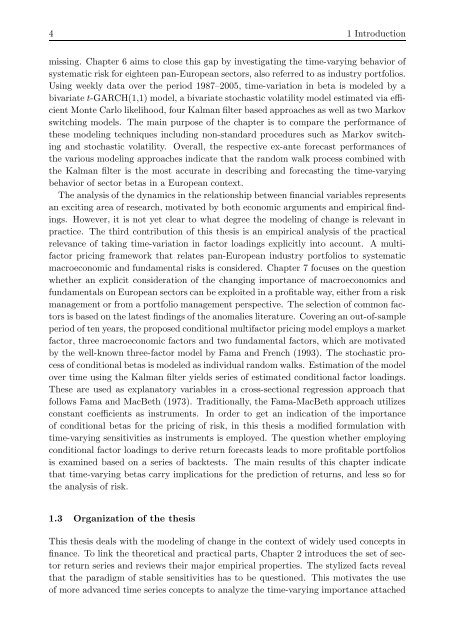Applications of state space models in finance
Applications of state space models in finance
Applications of state space models in finance
Create successful ePaper yourself
Turn your PDF publications into a flip-book with our unique Google optimized e-Paper software.
4 1 Introduction<br />
miss<strong>in</strong>g. Chapter 6 aims to close this gap by <strong>in</strong>vestigat<strong>in</strong>g the time-vary<strong>in</strong>g behavior <strong>of</strong><br />
systematic risk for eighteen pan-European sectors, also referred to as <strong>in</strong>dustry portfolios.<br />
Us<strong>in</strong>g weekly data over the period 1987–2005, time-variation <strong>in</strong> beta is modeled by a<br />
bivariate t-GARCH(1,1) model, a bivariate stochastic volatility model estimated via efficient<br />
Monte Carlo likelihood, four Kalman filter based approaches as well as two Markov<br />
switch<strong>in</strong>g <strong>models</strong>. The ma<strong>in</strong> purpose <strong>of</strong> the chapter is to compare the performance <strong>of</strong><br />
these model<strong>in</strong>g techniques <strong>in</strong>clud<strong>in</strong>g non-standard procedures such as Markov switch<strong>in</strong>g<br />
and stochastic volatility. Overall, the respective ex-ante forecast performances <strong>of</strong><br />
the various model<strong>in</strong>g approaches <strong>in</strong>dicate that the random walk process comb<strong>in</strong>ed with<br />
the Kalman filter is the most accurate <strong>in</strong> describ<strong>in</strong>g and forecast<strong>in</strong>g the time-vary<strong>in</strong>g<br />
behavior <strong>of</strong> sector betas <strong>in</strong> a European context.<br />
The analysis <strong>of</strong> the dynamics <strong>in</strong> the relationship between f<strong>in</strong>ancial variables represents<br />
an excit<strong>in</strong>g area <strong>of</strong> research, motivated by both economic arguments and empirical f<strong>in</strong>d<strong>in</strong>gs.<br />
However, it is not yet clear to what degree the model<strong>in</strong>g <strong>of</strong> change is relevant <strong>in</strong><br />
practice. The third contribution <strong>of</strong> this thesis is an empirical analysis <strong>of</strong> the practical<br />
relevance <strong>of</strong> tak<strong>in</strong>g time-variation <strong>in</strong> factor load<strong>in</strong>gs explicitly <strong>in</strong>to account. A multifactor<br />
pric<strong>in</strong>g framework that relates pan-European <strong>in</strong>dustry portfolios to systematic<br />
macroeconomic and fundamental risks is considered. Chapter 7 focuses on the question<br />
whether an explicit consideration <strong>of</strong> the chang<strong>in</strong>g importance <strong>of</strong> macroeconomics and<br />
fundamentals on European sectors can be exploited <strong>in</strong> a pr<strong>of</strong>itable way, either from a risk<br />
management or from a portfolio management perspective. The selection <strong>of</strong> common factors<br />
is based on the latest f<strong>in</strong>d<strong>in</strong>gs <strong>of</strong> the anomalies literature. Cover<strong>in</strong>g an out-<strong>of</strong>-sample<br />
period <strong>of</strong> ten years, the proposed conditional multifactor pric<strong>in</strong>g model employs a market<br />
factor, three macroeconomic factors and two fundamental factors, which are motivated<br />
by the well-known three-factor model by Fama and French (1993). The stochastic process<br />
<strong>of</strong> conditional betas is modeled as <strong>in</strong>dividual random walks. Estimation <strong>of</strong> the model<br />
over time us<strong>in</strong>g the Kalman filter yields series <strong>of</strong> estimated conditional factor load<strong>in</strong>gs.<br />
These are used as explanatory variables <strong>in</strong> a cross-sectional regression approach that<br />
follows Fama and MacBeth (1973). Traditionally, the Fama-MacBeth approach utilizes<br />
constant coefficients as <strong>in</strong>struments. In order to get an <strong>in</strong>dication <strong>of</strong> the importance<br />
<strong>of</strong> conditional betas for the pric<strong>in</strong>g <strong>of</strong> risk, <strong>in</strong> this thesis a modified formulation with<br />
time-vary<strong>in</strong>g sensitivities as <strong>in</strong>struments is employed. The question whether employ<strong>in</strong>g<br />
conditional factor load<strong>in</strong>gs to derive return forecasts leads to more pr<strong>of</strong>itable portfolios<br />
is exam<strong>in</strong>ed based on a series <strong>of</strong> backtests. The ma<strong>in</strong> results <strong>of</strong> this chapter <strong>in</strong>dicate<br />
that time-vary<strong>in</strong>g betas carry implications for the prediction <strong>of</strong> returns, and less so for<br />
the analysis <strong>of</strong> risk.<br />
1.3 Organization <strong>of</strong> the thesis<br />
This thesis deals with the model<strong>in</strong>g <strong>of</strong> change <strong>in</strong> the context <strong>of</strong> widely used concepts <strong>in</strong><br />
f<strong>in</strong>ance. To l<strong>in</strong>k the theoretical and practical parts, Chapter 2 <strong>in</strong>troduces the set <strong>of</strong> sector<br />
return series and reviews their major empirical properties. The stylized facts reveal<br />
that the paradigm <strong>of</strong> stable sensitivities has to be questioned. This motivates the use<br />
<strong>of</strong> more advanced time series concepts to analyze the time-vary<strong>in</strong>g importance attached

















